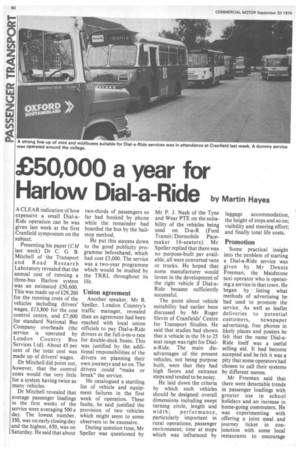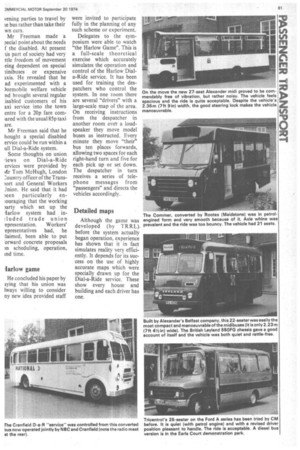£50,000 a year for
Page 82

Page 83

If you've noticed an error in this article please click here to report it so we can fix it.
Harlow Dial-a-Ride by Martin Ha yes A CLEAR indication of how expensive a small Dial-aRide operation can be was given last week at the first Cranfield symposium on the subject.
Presenting his paper (CM last week) Dr C. G. B. Mitchell of the Transport and Road Research Laboratory revealed that the annual cost of running a three-bus Harlow system was an estimated £50,600. This was made up of £29,200 for the running costs of the vehicles including drivers' wages, £13,800 for the cost control centre, and £7,600 for standard National Bus Company overheads (the service is operated by London Country Bus Services Ltd). About 45 per cent of the total cost was made up of drivers' wages.
Dr Mitchell did point out, however, that the control costs would rise very little for a system having twice as many vehicles.
Dr Mitchell revealed that average passenger lOadings in the first weeks of the service were averaging 500 a day. The lowest number, 350, was on early closing day and the highest, 650, was on Saturday. He said that about two-thirds of passengers so far had booked by phone while the remainder had boarded the bus by the hailstop method.
He put this success down to the good publicity programme beforehand, which had cost £3,000. The service was a two-year programme whichwould be studied by the TRRL throughout its life.
Union agreement
Another speaker, Mr B. Speller, London Country's traffic manager, revealed than an agreement had been reached with local union officials to pay Dial-a-Ride drivers at the full o-m-o rate for double-deck buses. This was justified by the additional responsibilities of the drivers on planning their own journeys and so on. The drivers could "make or break" the service.
He catalogued a startling list of vehicle and equipment failures in the first week of operation. These faults, he said justified the provision of two vehicles which might seem to some observers to be excessive.
During question time, Mr Speller was questioned by Mr P. J. Nash of the Tyne and Wear PTE on the suitability of the vehicles being used on D-a-R (Ford Transit/ Dormobile Pacemaker 16-seaters). Mr Speller replied that there was no purpose-built psv available, all were converted vans or trucks. He hoped that some manufacturer would invest in the development of the right vehicle if Dial-aRide became sufficiently successful.
The point about vehicle suitability had earlier been discussed by Mr Roger Slevin of Cranfields' Centre for Transport Studies. He said that studies had shown that a vehicle in the 16 to 25 seat range was right for Diala-Ride. The main disadvantages of the present vehicles, not being purpose built, were that they had high floors and entrance steps and tended to be noisy.
He laid down the criteria by which such vehicles should be designed: overall dimensions including swept turning circle, length and width; performance, particularly important in rural operations; passenger environment; time at stops which was influenced by luggage accommodation, the height of steps and so on; visibility and steering effort; and finally total life costs.
Promotion
Some practical insight into the problem of starting a Dial-a-Ride service was given by Mr Dennis Freeman, the Maidstone taxi operator who is operating a service in that town. He began by listing what methods of advertising he had used to promote the service. As well as leaflet deliveries to potential customers, newspaper advertising, free phones in likely places and posters he felt that the name Dial-aRide itself was a useful selling aid. It had become accepted and he felt it was a pity that some operators had chosen to call their systems by different names.
Mr Freeman said that there were detectable trends in passenger loadings with greater use in school holidays and an increase in home-going commuters. He was experimenting with offering a joint meal and journey ticket in conjunction with some local restaurants to encourage vening parties to travel by le bus rather than take their wn cars, Mr Freeman made a pecial point about the needs f the disabled. At present is part of society had very ttle freedom of movement eing dependent on special linibuses or expensive lxis. He revealed that he ad experimented with a )ormobile welfare vehicle nd brought several regular isabled customers of his axi service into the town entre for a 20p fare cornered with the usual 85p taxi are.
Mr Freeman said that he bought a special disabled ervice could be run within a ull Dial-a-Ride system. Some thoughts on union iews on Dial-a-Ride erviees were provided by dr Tom McHugh, London :ountry officer of the Trans)ort and General Workers Jnion, He said that it had leen particularly en:ouraging that the working )arty which set up the .-larlow system had inAuded trade union epresentation. Workers' .epresentatives had, he :laimed, been able to put brward concrete proposals m scheduling, operation, ind time.
Iarlow game
He concluded his paper by lying that his union was lways willing to consider ny new idea provided staff were invited to participate fully in the planning of any such scheme or experiment.
Delegates to the symposium were able to watch "the Harlow Game". This is a full-scale theoretical exercise which accurately simulates the operation and control of the Harlow Diala-Ride service. It has been used for training the despatchers who control the system. In one room there are several "drivers" with a large-scale map of the area. On receiving instructions from the despatcher in another room over a loudspeaker they move model buses as instructed. Every minute they move "their" bus ten places forwards, allowing two spaces for each right-hand turn and five for each pick up or set down. The despatcher in turn receives a series of telephone messages from "passengers" and directs the vehicles accordingly.
Detailed maps
Although the game was developed (by TRRL) before the system actually began operation, experience has shown that it in fact simulates reality very efficiently. It depends for its success on the use of highly accurate maps which were specially drawn up for the Dial-a-Ride service. These show every house and building and each driver has one.




































































































































































































































































































































































